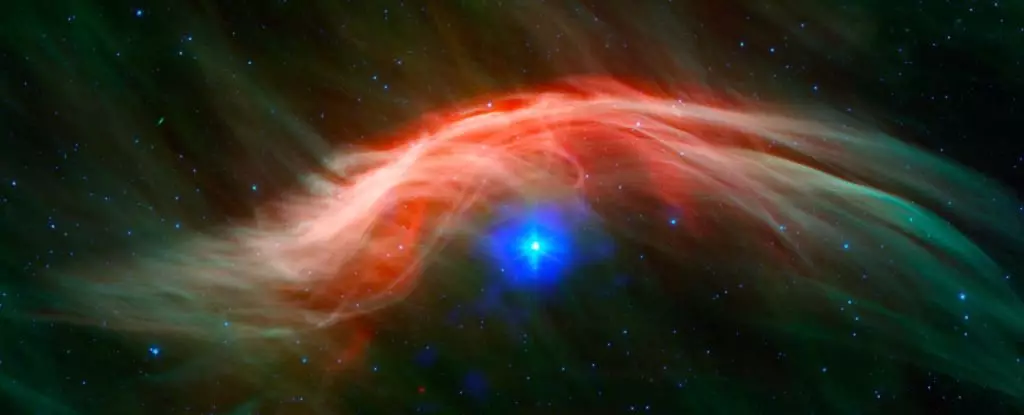In the vast tapestry of the universe, curious threads weave through seemingly unrelated phenomena, raising profound questions about the impact of cosmic events on life on Earth. A recent groundbreaking study led by astrophysicist Caitlyn Nojiri from the University of California, Santa Cruz, provides intriguing insights into how a supernova explosion billions of kilometers away might have influenced microbial diversity in Lake Tanganyika around 2.5 million years ago. By investigating the spike in virus diversity within this ancient lake, the researchers draw a tantalizing potential link to cosmic radiation emitted from a nearby stellar explosion. This research beckons us to ponder not only the enormity of the cosmos but also its intimate connections to the evolution of life on Earth.
Radiation has long been recognized as a pivotal factor in evolutionary processes on our planet. While evolution would undoubtedly continue without additional influences, the chaotic nature of cosmic radiation can instigate mutations in cellular structures—some beneficial, some detrimental, and many inconsequential. Nojiri emphasizes the excitement in uncovering how cosmic events like supernovae might intertwine with terrestrial existence, nudging evolution along in ways previously unexplored. The possibility that cosmic phenomena can have tangible effects on biological diversity compels us to consider our place within the universe differently: as interconnected entities shaped by cosmic forces.
Astronomers describe our Solar System as residing in a unique region of space known as the Local Bubble, characterized by a relative scarcity of stars. This bubble, intriguingly shaped by a series of historical supernova explosions, has implications for the radiation Earth’s biosphere experiences. Proximity to such supernova remnants significantly enhances radiation levels, implicating these stellar events in potential biological evolution on our planet. Nojiri’s study capitalizes on data derived from deep-sea sediment core samples, allowing a reconstructive analysis of Earth’s past environmental conditions, encompassing millions of years of geological and biological history.
Central to this research is iron-60, a radioactive isotope predominantly formed during supernova explosions. The presence of iron-60 in sediment layers provides a temporal bookmark, dating back to specific cosmic events. Previous studies identified notable spikes of iron-60 in ancient marine sediments, allowing researchers to chronicle two distinct supernova events—one occurring approximately 6.5 to 8.7 million years ago and the other between 1.5 and 3.2 million years ago. By meticulously tracking these isotopes back to their cosmic origins, Nojiri and her team illuminated a recent supernova explosion thought to have occurred between 2 and 3 million years ago, possibly sourced from the young star groups Scorpius-Centaurus or Tucana-Horologium.
When supernovae explode, they unleash a cascade of electromagnetic radiation and dispersive materials across vast distances. Following the hypothesized explosion in the Scorpius-Centaurus region, computer simulations indicated that Earth would be bombarded with intense cosmic radiation for approximately 100,000 years. The estimated increase in radiation levels could be significant, potentially elevating the annual dose to around 30 milligrays for Scorpius-Centaurus and 100 milligrays for Tucana-Horologium during the critical initial years post-explosion. With established research indicating that exposure to a mere 5 milligrays annually can begin to disrupt DNA, the potential ramifications for life forms in Lake Tanganyika—and beyond—are thought-provoking.
Although the findings do not incontrovertibly link cosmic radiation from the supernova to increased viral diversity in Lake Tanganyika, what stands out is the curious correlation in timing. In a world increasingly sensitive to disruptions in ecological balance, virus diversification is pivotal, especially in intricate ecosystems like that of the ancient lake. The implications of such studies stretch beyond theoretical confines, hinting at an intricate network of cosmic interdependencies influencing life on Earth.
Ultimately, this research sparks deeper contemplation about humanity’s place in the universe. As poetically put by Carl Sagan, we are all made of stardust, a reminder of the celestial materials that shape us. This recent study further accentuates the interconnectedness of the cosmos and Earth’s biological narrative, challenging us to view our existence not as isolated incidents, but as an evolution shaped by the cosmic ballet unfolding in our galaxy. As we explore the universe, we become acutely aware of how cosmic phenomena may subtly guide the march of evolution here on Earth, an exciting prospect that beckons further inquiry and appreciation.


Leave a Reply